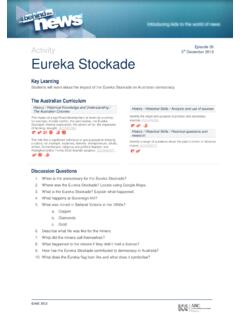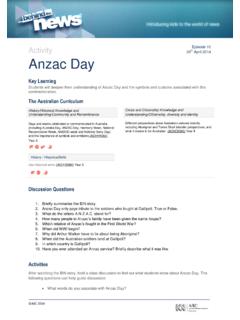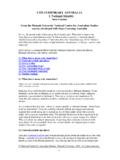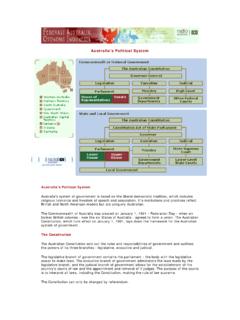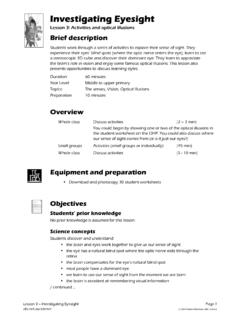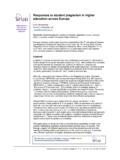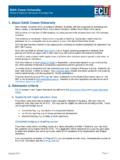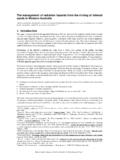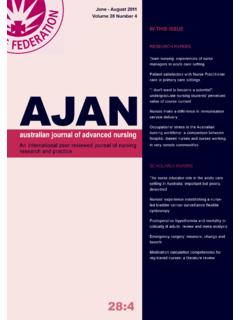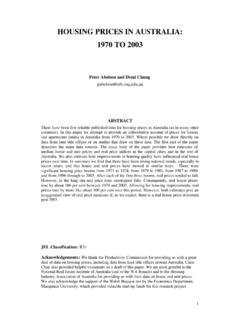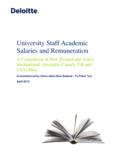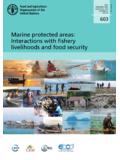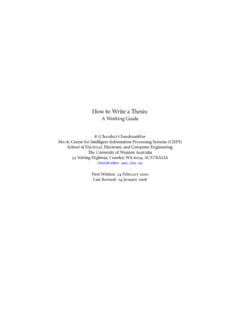Transcription of CONTEMPORARY AUSTRALIA 4. Environmental …
1 CONTEMPORARY AUSTRALIA . 4. Environmental Issues Sara Cousins From monash university 's National Centre for Australian Studies course, developed in conjunction with Open Learning AUSTRALIA In the fourth week of the course, Sara Cousins examines AUSTRALIA 's many diverse and beautiful environments. The struggle to retain this national heritage has been a prominent feature of CONTEMPORARY AUSTRALIA . The current generation must face the challenge of building a sustainable future in the world's driest continent. Sara Cousins is a research fellow with the National Centre for Australian Studies, monash university , Melbourne, AUSTRALIA .
2 AUSTRALIA 's world heritage environment Impact of European land use Environmental campaigns Global warming Land clearance Salinity and water issues Sustainable future? Further reading AUSTRALIA 's world heritage environment AUSTRALIA has one of the most diverse and beautiful environments in the world. There are currently fourteen world heritage listed sites in AUSTRALIA , including the Great Barrier Reef Marine Park in Queensland, Kakadu and Uluru Kata Tjuta (Ayers Rock) National Parks in the Northern Territory, the Greater Blue Mountains near Sydney and Shark Bay in Western AUSTRALIA . With only of the world's population in a continent nearly as big as the United States, it would be easy to assume that Australians have a lot of space and ample natural resources.
3 In fact, two thirds of the country is arid or semi-arid and only partly habitable due to the lack of permanent water. Both AUSTRALIA 's climate and annual rainfall are highly variable and only 6% of AUSTRALIA 's land is classed as arable. It is classed as the driest continent in the world and water is therefore the country's most precious commodity. AUSTRALIA is also one of the most highly urbanised in the world. Over 80% of Australians live in urban centres within 50 kilometres of the coast and these areas make up only about 1% of the total land mass of AUSTRALIA . Impact of European land use Agriculture accounts for the major use of land in AUSTRALIA 60% or 454 million hectares is agricultural land.
4 Agricultural products now make up about 3% of AUSTRALIA 's gross domestic product compared to 25% in 1950. Read overview of AUSTRALIA 's land resources. National Centre for Australian Studies, monash university , 2005. All rights reserved. 1. Over time, other industries such as manufacturing, mining and services have expanded significantly. However much of the damage to the environment from land clearing, desertification, salination, water degradation and soil acidity has already been done. Methods of agriculture imported from Europe by the first migrants to AUSTRALIA were highly unsuitable for the climate, particularly the limited rainfall, and soils.
5 AUSTRALIA , a continent millions of years old, has soils that are ancient, fragile and beset by accumulated salts. Land clearing - one third of native forests have already gone to make way for agriculture, mining and forestry - has resulted in a huge loss of biodiversity and severe soil erosion. Read more . Environmental campaigns Far from being merely an historical issue, many would argue that today, with the benefit of highly sophisticated scientific data and technology at its disposal, the government is still not committing the financial resources that are needed to combat the extent of the problem. Over the past thirty years, Environmental campaigns have expanded, strengthened and in some cases managed to halt development threatening serious degradation to the natural environment.
6 A turning point in the history of such Environmental activism occurred in the early 1980s concerning the Franklin River in Tasmania, where the State Government planned to build a dam for the production of hydroelectricity. The intense campaign led to a term of imprisonment for the most prominent activist, Bob Brown, and to a High Court case that upheld the Commonwealth's world heritage legislation. Bob Brown subsequently became leader of The Australian Greens and is currently Senator for Tasmania in Federal Parliament. Activists and Environmental lobby groups today such as the Australian Conservation Foundation, Greenpeace, The Wilderness Society and Friends of the Earth AUSTRALIA , focus their attention on major issues such as climate change, land clearing, soil and water degradation, loss of biodiversity and damage to the coastal and marine environment.
7 It is not only environmentalists who are raising issues of concern regarding AUSTRALIA 's environment. Explore AUSTRALIA 's landscape and biodiversity. Many farmers, Indigenous landowners, scientists, and industry and community groups are voicing their views about the need for a sustainable approach to managing AUSTRALIA 's precious natural resources. See for example, the policy statements of the National Farmers Federation, the Indigenous Land Corporation and the Wentworth Group of Concerned Scientists. Global warming While there is still some debate, scientific research has shown that the earth is gradually warming with average temperatures in AUSTRALIA rising since the beginning of the twentieth century.
8 Global warming is largely the result of increases in greenhouse gas emissions and carbon dioxide concentration and their effect on the earth's atmosphere. The impact on AUSTRALIA , particularly its agricultural industry, could be significant. Australian farmers have already experienced the combined effects of the El Nino weather pattern, warmer temperatures, less rainfall, longer droughts and more severe bushfires. Native forests, wetlands, riverine environments, alpine ecosystems and marine environments are National Centre for Australian Studies, monash university , 2005. All rights reserved. 2. likely to become even more vulnerable.
9 Rising sea-levels and extreme weather may threaten urban and coastal communities. Internationally, efforts have been made to combat the effects of climate change through agreements such as The Kyoto Protocol. This treaty, part of a wider global Environmental governance movement, creates targets by which developed countries will limit their greenhouse gas emissions. AUSTRALIA signed the treaty in 1997, making a commitment to limit emissions growth to 108% of its 1990 level. In 2002 however, the Howard Government announced that AUSTRALIA would not ratify the treaty because it excluded developing countries and the United States.
10 Read Government's press release. Debate about whether or not AUSTRALIA should ratify the Kyoto Protocol continues to dominate discussion of appropriate global responses to climate change. Land clearance Over a century of land clearing for agriculture has resulted in the significant loss of native forest and woodlands in AUSTRALIA . Much of the land clearing has occurred since 1980. The Federal Government has spent a substantial amount of money and committed resources to repairing the environment under the National Heritage Trust and the National Landcare Program. However, according to Environmental lobby groups, land clearing has in fact increased in the past five or so years with most of the damage occurring in Queensland, New South Wales and Tasmania.
